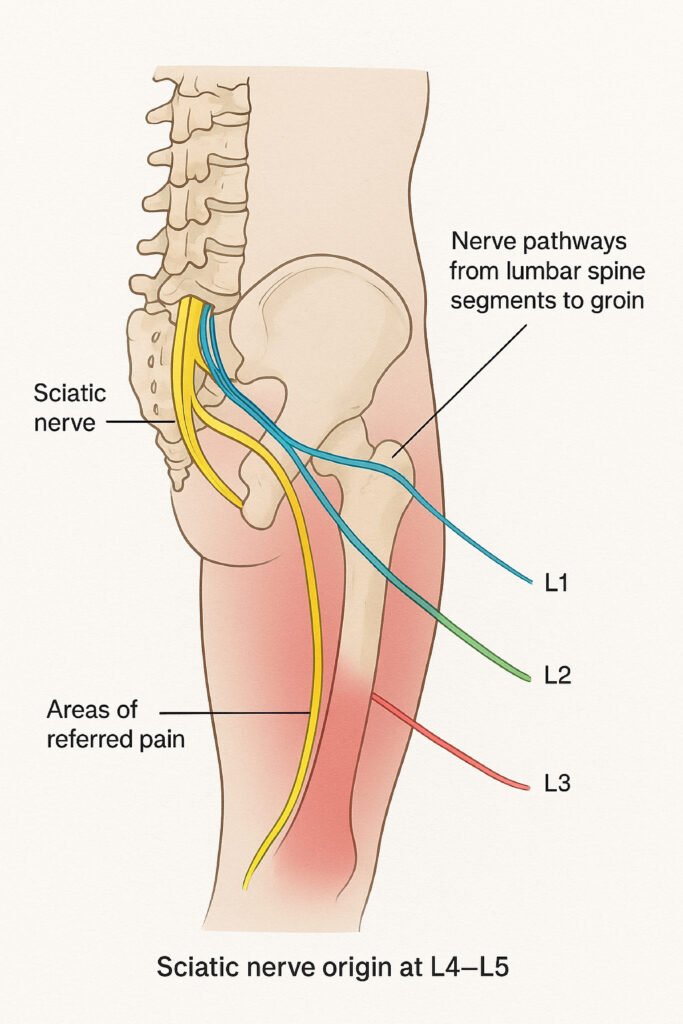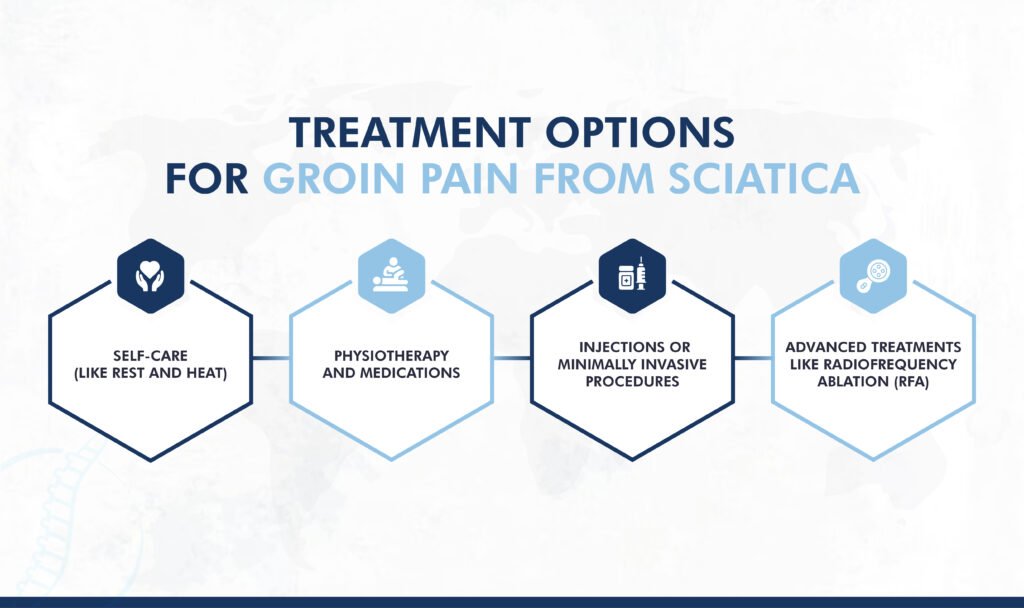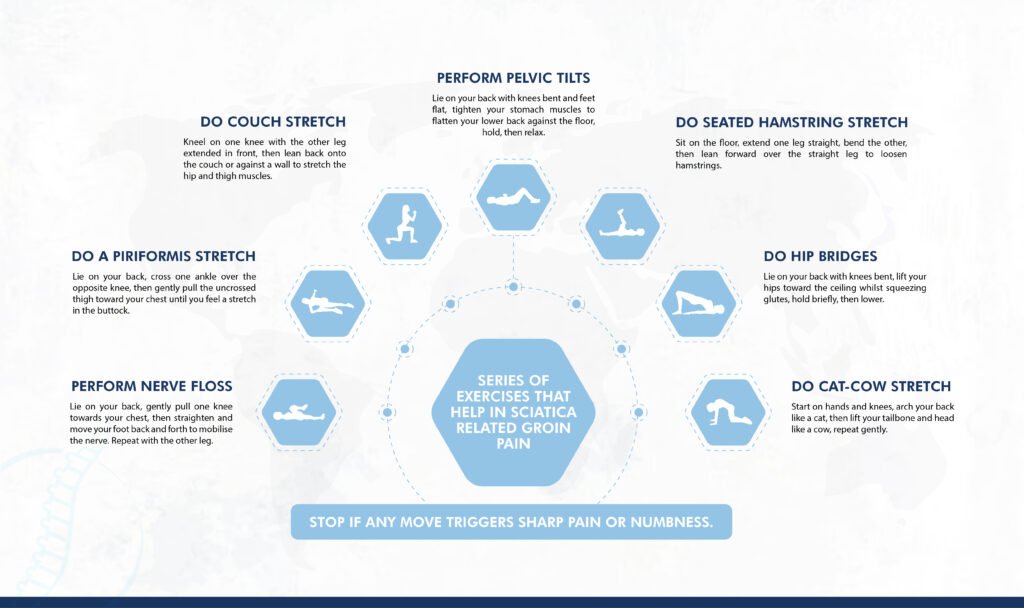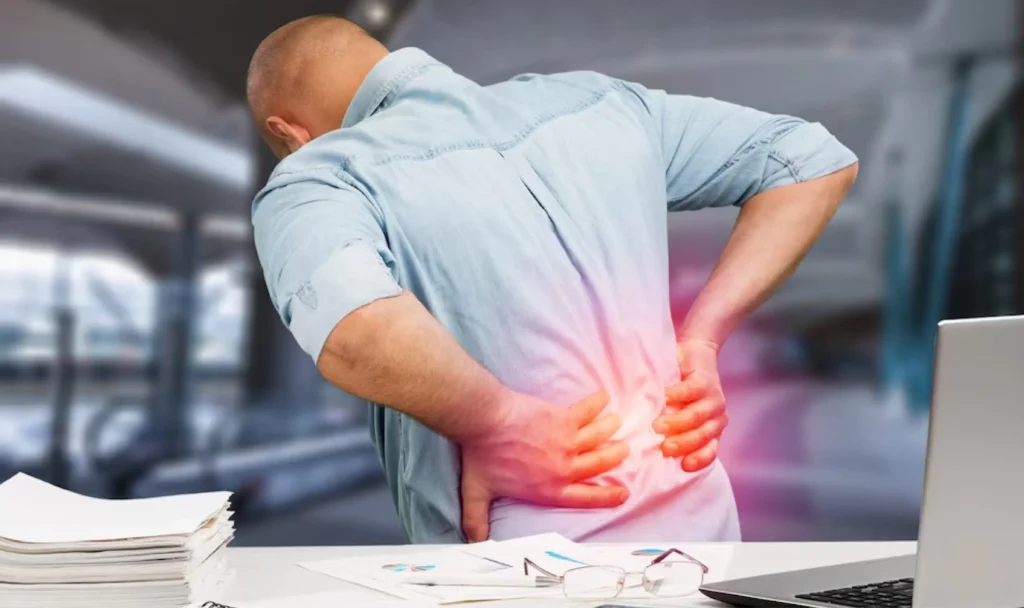Does sciatica cause groin pain? While it’s less common, sciatica can cause groin pain, especially involving L2–L3 nerve roots. Typically, sciatica affects the leg and lower back, but referred pain may appear in the groin. Proper diagnosis through examination is vital, as treatment ranges from self-care and physiotherapy to injections or surgery, depending on severity.
When to Seek Urgent Medical Help
- Bladder or bowel changes
- Saddle numbness
- Rapid weakness in legs
TL;DR:
- Groin pain often stems from upper lumbar nerves L2 to L4.
- Sciatica typically affects the back and leg, not the groin.
- Diagnosis guides treatment: physio, medications, injections, or surgery.
- UK clinics offer support, self-management, and specialist care.
- Book an assessment if pain persists over 6 weeks or worsens.
Table of Contents
What Is Sciatica?
Sciatica is a condition characterised by pain along the pathway of the sciatic nerve, caused by nerve irritation or compression. It affects around 40% of people at some stage in their lives [source: National Institutes of Health (NIH)].
Sciatica can cause sharp, shooting pain in your lower back, radiating all the way down the buttocks, legs, or feet. Symptoms may also include tingling, numbness, or muscle weakness. Usually, it affects only one side, but in some cases, it affects both.
The good news is that most patients improve with proper management in 3 months.
What Causes Sciatica?
The sciatic nerve, the longest and thickest nerve in your body, can be irritated or compressed by various factors. Approximately 5-10% of the population with lower back pain experiences sciatica at some point (source: NHS). Common causes include:
Herniated or Slipped Disc: A bulging disc pressing on the nerve roots, causing burning, numbness, or tingling down the leg.
Spinal Stenosis: Narrowing of the spinal canal, often in older adults, putting pressure on nerves.
Bone Spurs: Extra bone growths along the spine that irritate nearby nerves.
Muscle Tightness: Overuse or poor posture can tighten muscles like the piriformis, impinging the nerve (piriformis syndrome).
Pregnancy and Prolonged Sitting: Extra pressure from pregnancy or sitting for long periods can trigger symptoms.
Does Sciatica Cause Groin Pain?
When you experience groin pain, sciatica may be the last cause you consider, as it doesn’t usually directly affect the groin. However, nerves from L2 to L4 can cause referred pain that radiates from the lower back or buttocks to the groin, often with deep, aching sensations on one side.
Experiencing groin pain with sciatica is more common than you think. Pain may worsen with sitting, bending, or walking.
“I’ve been dealing with sciatica on the left side of my lower back and hip for a couple of months. It got worse after starting a new job that involves sitting all day. I used to wear high heels daily but switched to flats, which helped a bit. Now I’m feeling new pain in my left groin. I thought it was an ingrown hair, but everything looks normal. Can sciatica spread to the groin?”
Yes, sciatic pain can also spread to your groin, although it’s less typical. It may feel like your groin is the problem, but it’s just referred pain from your lower back or buttocks, where the pathways of sciatic nerves are. Be sure to get your upper lumbar nerves checked first.
If you’re suffering from groin pain, get your proper diagnosis at a Back Pain Clinic in Harley Street, London. Dr Yasser Mehrez offers advanced consultations for most types of body pain.
How Does Sciatica Affect the Groin Area?
Groin pain related to nerve issues is often referred pain originating from nerves in the lower spine, especially from upper lumbar radiculopathy involving L2 to L4. The sciatic nerve itself, formed from nerve roots in the L4 to S3 regions, rarely causes direct groin pain.
Nerves from L1 to L3, part of the lumbar plexus, do not directly cause sciatica or pass through the groin. When these lower nerve roots are irritated, they can produce groin pain along with other sciatica symptoms, as the brain interprets signals from the affected area.

“Earlier this year, I was rear-ended and ended up with herniated discs at the bottom of my spine. I went to a chiropractor for a few months and got some better, but I haven’t been back in about five months. Lately, I’ve felt deep pressure in my lower back. When I’m lying down, I get tingling and burning in my thighs and groin, but it goes away when I stand up and move.”
As per the symptoms, the user is suspected to have early sciatica or nerve irritation related to their herniated discs. They should monitor their symptoms and avoid positions that increase the pain.
Sciatica Groin Pain Symptoms
Sciatic pain in groin may come in a combination of symptoms such as:
- Dull or burning groin pain
- Pain radiating from lower back to groin
- Tingling or numbness and inner thigh pain
- Pain that gets worse whilst sitting or standing too long
- Relief when lying flat or gently stretching the lower back
Is It Sciatica or a Groin Injury?
It can be challenging to determine the cause of your groin pain, whether it’s from an injury/wrong movement or sciatica.
However, here’s a quick way to spot their differences:
- If the pain is sharp and localised, especially after you’ve exercised or made a sudden move, it’s most likely a groin injury.
- If the pain starts in your lower back or hip then travels to your groin, it’s a strong sign of sciatica.
With sciatica, you may also experience numbness, tingling, or a burning sensation along the sciatic nerve pathway. Injuries in the groin region, on the other hand, don’t normally come with these symptoms.
For accurate diagnosis and treatment, get advanced hip pain service from Dr Yasser Mehrez. He offers walk-in consultations in Harley Street, London, and is available anytime for e-consultations.

Real Reddit Case: Groin and Hip Pain on Both Sides
One user reported experiencing groin and hip pain on both sides for 15 months, describing it as “minor disc bulge only.”
Note: Patient stories reflect personal experiences and are not a substitute for professional medical advice.
Such symptoms may be due to referred pain from nerve irritation, such as from sciatica or other nerve issues.
Clinical takeaway: Persistent groin pain lasting over 3 months warrants evaluation by a healthcare professional for accurate diagnosis and treatment.
How to Diagnose Sciatica Groin Pain?
Groin pain has many possible causes, including nerve irritation like sciatica or musculoskeletal injuries. Accurate diagnosis involves a combination of at-home checks, clinical assessment, and potentially diagnostic tests.
At-home checks:
- Note when pain worsens (movement, sitting, standing)
- Check for numbness, tingling, or weakness
- Observe if pain radiates from back to groin
Triage steps:
- Sudden weakness, loss of bladder or bowel control
- Saddle numbness or severe, persistent pain
- Symptoms worsening rapidly or associated with injury
Medical assessment:
- Physical tests such as straight leg raise and slump test
- Imaging (MRI, EMG, CT) to confirm nerve compression
- Patient history review to identify worsening or associated signs
Cauda Equina Syndrome (CES) or Sciatica?
This Reddit user worries their groin pain may be due to Cauda Equina Syndrome, a rare but serious condition.
“In 2022, I had a bad sciatica flare-up that improved after two months of steroids, muscle relaxers, and physiotherapy. In January, a couple’s massage worsened an undiagnosed disc herniation. An MRI showed an 11mm L5-S1 disc protrusion. Sitting and lying down are fine, but standing or walking triggers leg pain and persistent pins and needles in my right foot. Physiotherapy isn’t helping, and groin pressure has me worried about cauda equina syndrome.”
It’s important to note that CES can only be diagnosed by a healthcare professional. Consult with Dr Yasser Mehrez if you experience symptoms such as significant leg weakness, numbness, bladder or bowel changes, or saddle numbness.
Treatment Options for Groin Pain from Sciatica
First, you need to have a proper diagnosis confirming your groin pain is due to sciatica. Treatment will then depend on the severity of your symptoms and response to conservative measures.

Self-Management of Sciatica at Home
You can often ease sciatica symptoms at home by staying active, such as with gentle walking and stretching. Avoid long periods of sitting or standing and keep good posture to reduce back strain. Using cold packs first, then heat, can help with pain and muscle tightness.
• Heat/Cold Therapy
Applying heat can relax tight muscles, whilst cold packs reduce swelling and numb sharp pain. Using both at different times can soothe irritated nerves and speed up recovery.
Physiotherapy and Medication
Physiotherapy and medication are your next choice if self-management isn’t providing the relief you expected. Physiotherapy is considered one of the most effective conservative treatment protocols to treat sciatica or related conditions.
• Physiotherapy
If you follow a regular physical therapy plan, it will help strengthen your muscles, including the core, glutes, and groin muscles, which are the key muscles responsible for groin pain due to sciatica. A well-followed physiotherapy plan can ease pressure on the sciatic nerve and reduce pain over time.
• NSAIDs or Analgesics
Anti-inflammatory medicines or NSAIDs can greatly help reduce inflammation and relieve pain. Make sure to use them as directed by your doctor after proper evaluation.
• Steroid Injections
Steroid injections offer temporary relief by reducing swelling around the nerve if your inflammation persists. These are only recommended when other treatments don’t work.
Exercises That Help in Sciatica-Related Groin Pain
The NHS recommends exercises for sciatica–related groin pain,. Here’s some quick and easy exercises you can follow:

Advanced Treatment Options
If conservative treatments such as physiotherapy, medication, and self-management do not relieve your groin or sciatica pain, advanced options are available following NICE guidelines and UK clinical pathways. A thorough diagnosis is necessary before progressing to these treatments.
1. Epidural Infiltration
2. Epidural Steroid Injections (ESI)
Epidural steroid injections reduce inflammation around irritated nerves but may require repeat treatments and don’t fix the underlying cause. (Supported by NHS/NICE guidelines)
3. Fluoroscopic Guided Injections (FGI)
4. Radiofrequency Ablation (RFA)
Radiofrequency ablation uses heat to block pain signals from specific nerves. It provides longer-lasting relief but only for select cases. A specialist will only consider advanced options like RFA after a thorough diagnosis and after more conservative treatments have been proven ineffective.
5. Surgery (in severe cases)
If your pain is caused by a herniated disc or severe nerve compression that doesn’t improve with conservative treatments, surgery is the last option to relieve symptoms.
Consult specialist Dr. Yasser Mehrez for assessment and treatment planning, following UK clinical pathways and NICE guidelines.
When to See a Specialist
If you experience the following, you need to consult a pain-management specialist for targeted treatment:
- Persistent groin pain lasting over 2 weeks
- Numbness or weakness in the leg or groin
- Loss of bladder or bowel control
- Saddle numbness
- Fever with severe back pain
- Rapid weakness
- Pain not improving with rest or home care
If your symptoms are worsening over time, seek urgent care. Dr Yasser Mehrez offers accurate diagnosis and targeted pain management.
FAQs
Is groin pain linked to lumbar nerve roots?
Yes, in some cases, groin pain can be referred from nerve root compression in the lumbar spine, especially at levels L2–L3. This type of pain is typically tingling, burning, or numbness rather than a localised muscle strain.
How does a typical sciatica pattern compare to groin strain?
Sciatica usually begins in the lower back or buttock and radiates down the leg, often following the nerve pathway. Groin strain tends to stay localised in the groin area and worsens after activity, without radiating down the leg.
What are the warning signs that require urgent assessment?
Urgent assessment is needed if you experience new bladder or bowel problems, saddle numbness, sudden weakness in the legs, or if you have a fever with severe back pain. These symptoms could indicate serious nerve or spinal issues that require immediate medical attention.
How do I know if my groin pain is from a pinched nerve?
If your groin pain is accompanied by back pain, leg numbness, or weakness, it’s likely related to a pinched nerve rather than a muscle injury.
Can a herniated disc cause groin pain?
Yes, herniated discs at the upper lumbar levels, particularly L2–L3, can irritate nearby nerve roots and cause referred pain to the groin or inner thigh. This pain often worsens with movement and may be accompanied by leg numbness or weakness.
What treatments are best for groin pain caused by sciatica?
Due to the complexity and nature of the condition, sciatica pain in groin requires combined therapies. It includes physiotherapy, medication, and proper exercise plan. If these conservative options don’t work, you may need steroid injections or surgery.
What home steps can help ease symptoms?
Gentle activities like short walks and taking regular posture breaks can help reduce nerve irritation, whilst applying heat or ice may alleviate pain. Sleeping on your side with a pillow between your knees can also improve spinal alignment and comfort.
Disclaimer
These Reddit posts are user experiences for educational context only and do not replace professional medical advice.
Relieve Your Pain with Dr Yasser Mehrez – Harley Street, London
With over 20 years of expertise in pain management, Dr Yasser Mehrez offers personalised treatment plans tailored to your needs. His proven methods have helped many patients in the UK regain control of their lives after chronic pain.
Book your appointment today:
Call us at +44 (0) 190 801 4486 or click here to book online and take the first step toward a pain-free life.







